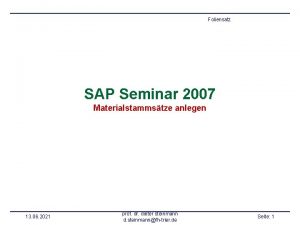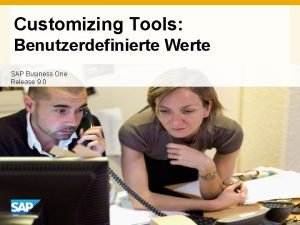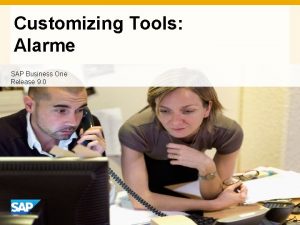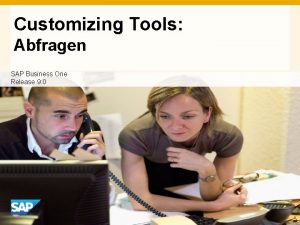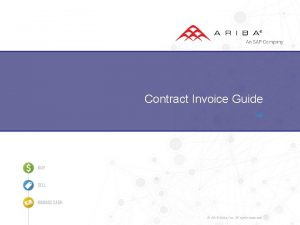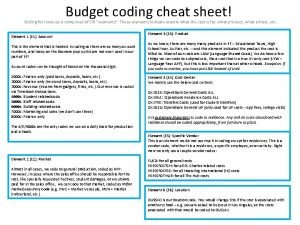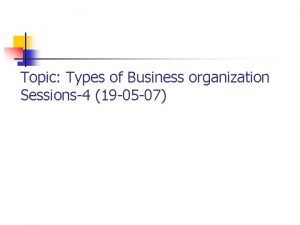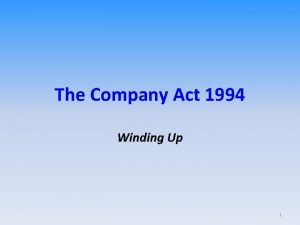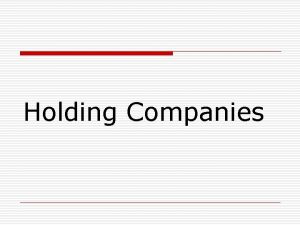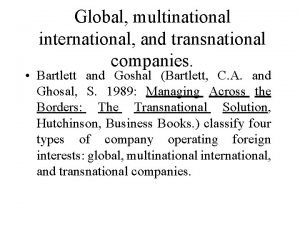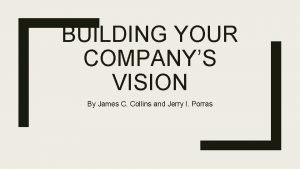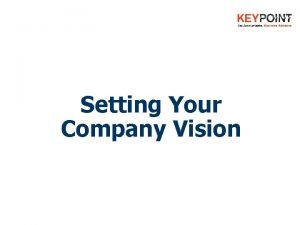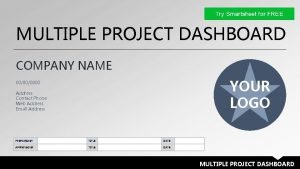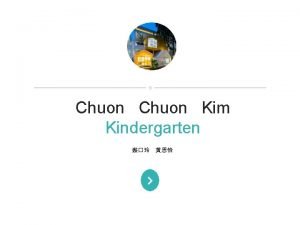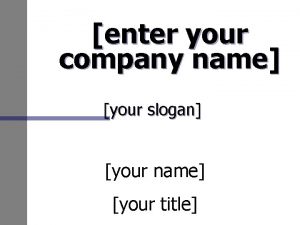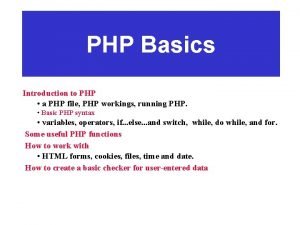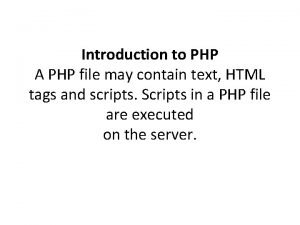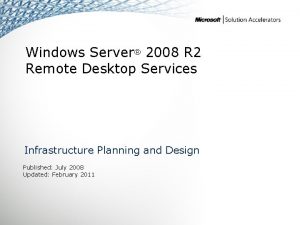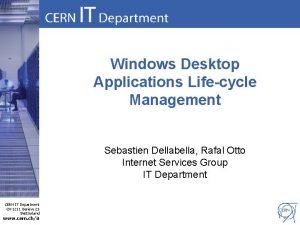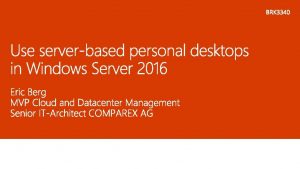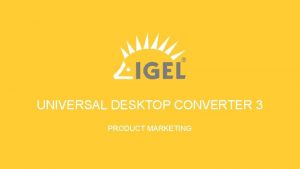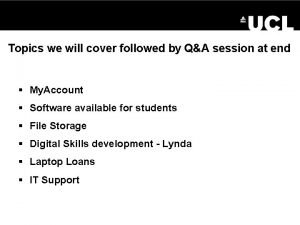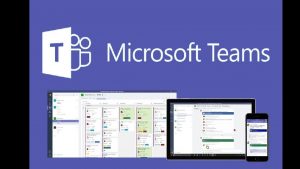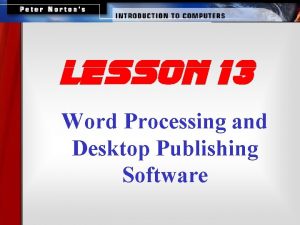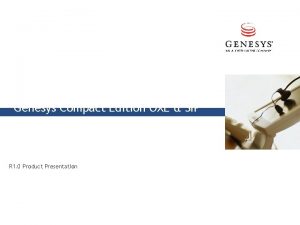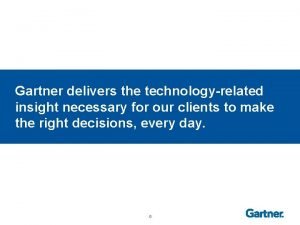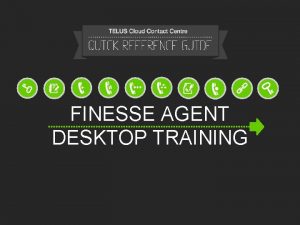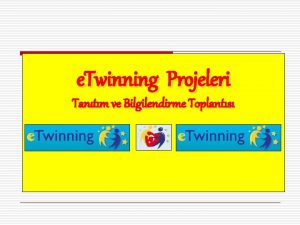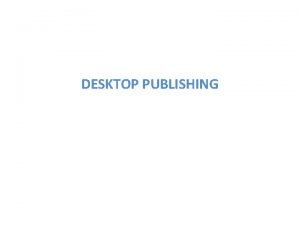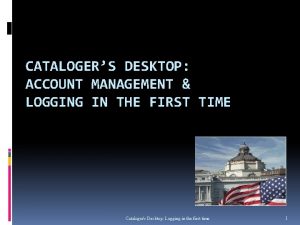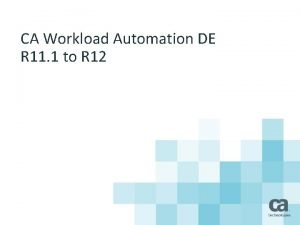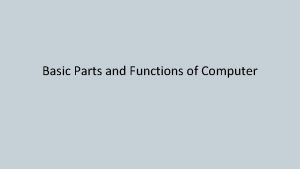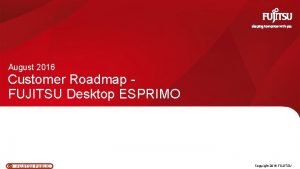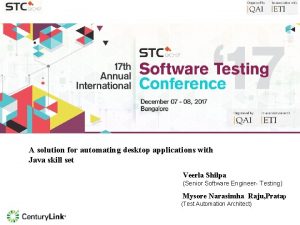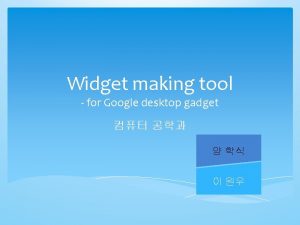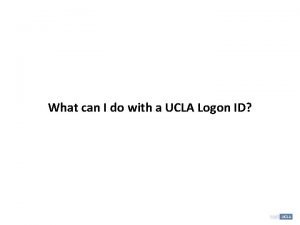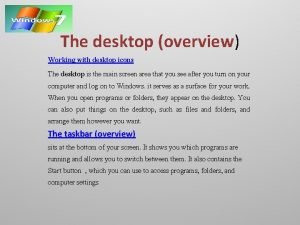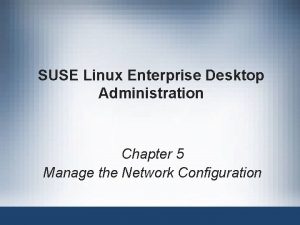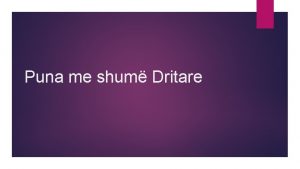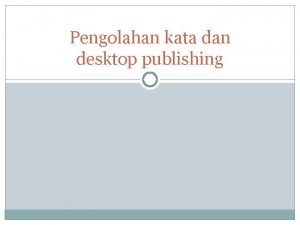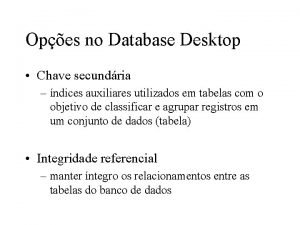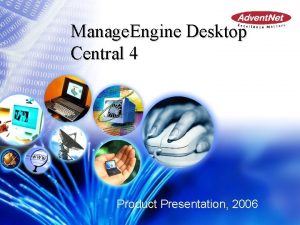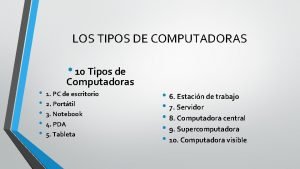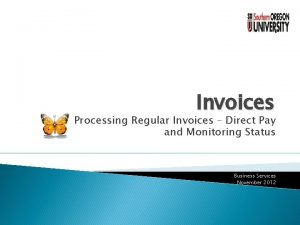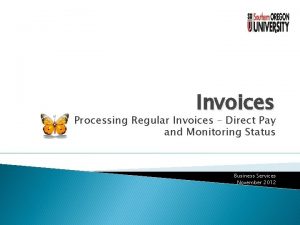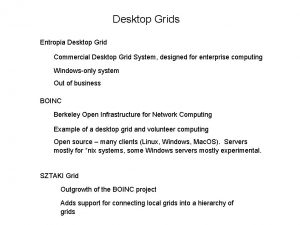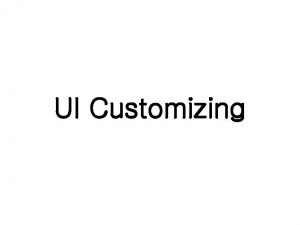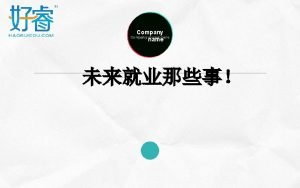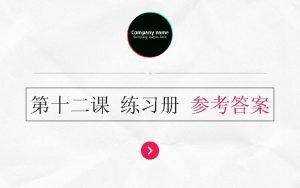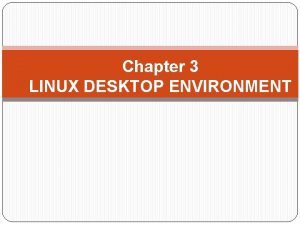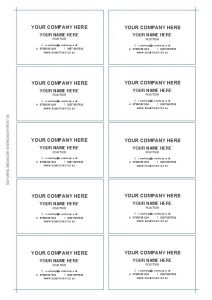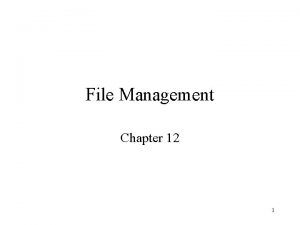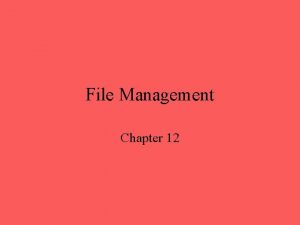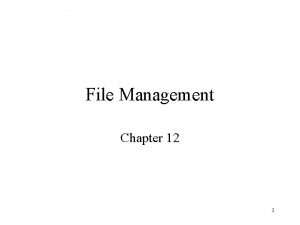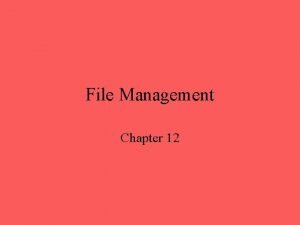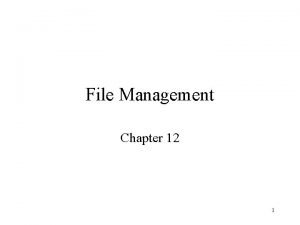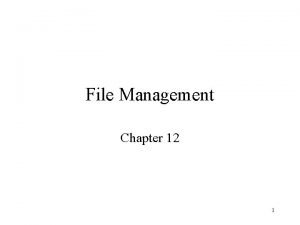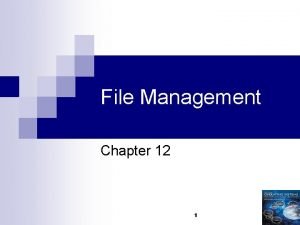12 Chapter Customizing Your Company File Desktop Invoices









































































- Slides: 73


12 Chapter Customizing Your Company File Desktop, Invoices, Letters, Memorized Transactions, Graphs, and Fiscal Year © Paradigm Publishing, Inc. 2

Objectives In this chapter, you will: • Customize the desktop with the Home page and Icon bars • Customize Lists/Centers, including subaccounts, merge entries, and custom fields • Customize Activities, including an Activity window display and related invoice, Quick. Books Letter in Microsoft Word, memorize transactions • Customize Reports, including the appearance of reports, memorize settings, export a report into Microsoft Excel, process multiple reports, change report default settings, view and print a graph • View fiscal year closing, set closing date, prepare for new fiscal year © Paradigm Publishing, Inc. 3

Introduction • In this final chapter, you will learn how to customize the desktop; customize Lists/Centers by changing subaccount default settings, merging entries, and creating custom fields; and customize Activities by personalizing the Create Invoices window and related printed invoices. • Then you will learn how to prepare a Quick. Books Letter in Microsoft Word and memorize transactions. • Next you will learn how to customize Reports and memorize the settings, export a report to Microsoft Excel, process multiple reports, change report default settings, and view and print graphs. • Finally, you will conclude the accounting cycle in Quick. Books by viewing fiscal year closing, setting the closing date, and preparing for the new fiscal year. © Paradigm Publishing, Inc. 4

Customize The Desktop • You may have observed that there are many different ways to access Lists/Centers, Activities windows, and Reports in Quick. Books. • Throughout the text only the main menu bar was used to illustrate accessing the Lists/Center, Activities windows, and Reports. • You can customize your desktop to use the Home page and/or the Icon bars as alternative ways to access these items. © Paradigm Publishing, Inc. 5

Using the Home Page © Paradigm Publishing, Inc. 6

Using the Home Page Cont. • By default when you create a new company file, and each time you open a company file, the Home page is displayed. • If the default was changed and the Home page is not automatically displayed it can be accessed for the current work session or the default can be changed so that the Home page displays each time the company file is opened. • In addition, the Home page can be customized to your choices. © Paradigm Publishing, Inc. 7

Using the Home Page Cont. Quick. Books offers two tabs on the Home page • Home page tab – Five sections of the Home page are labeled with tabs: • • • VENDORS CUSTOMERS EMPLOYEES COMPANY BANKING • Insights tab – Provides information about the company at a glance. • Profit & Loss • Income • Expenses © Paradigm Publishing, Inc. 8

Customize the Home Page • Icons are added or removed from the Home page depending on the preferences for the company file. • Recall in the New Company Setup chapters, that when you create a new company file, the Quick. Books preferences, or features, are turned on (enabled) or turned off (disabled). – In Chapter 6, the preferences were enabled or disabled as you answered questions in the Easy. Step Interview window. – In Chapter 7, you went directly to the Preferences window to enable or disable preferences. • As a preference is enabled, choices appear on the dropdown menus on the main menu bar and also on the Home page. • If a preference is enabled, you cannot remove the icon from the Home page. © Paradigm Publishing, Inc. 9

Customize the Home Page Cont. • In Chapter 12, most preferences for our sample company Kristin Raina Interior Designs have been enabled. • If you look at the Home page for a company file in the earlier chapters, you will see fewer icons on the Home page. – For example, look at figure 1 -H on page 1 -12. • Currently Kristin Raina is not using Estimates. • Look at the Home page and observe in the Customers section that there is not an Estimates icon. • Upon enabling the Estimates preference, the icon will appear on the Home page. © Paradigm Publishing, Inc. 10

Customize the Home Page Cont. © Paradigm Publishing, Inc. 11

Customize the Home Page Cont. • Along the right side of the Home page are three areas of information titled: – Account Balances – Do More with Quick. Books – Backup Status • While you cannot remove these categories from the Home page, you can minimize the detail below each heading by clicking on the up arrow. – When you click this arrow, only the information title is displayed. – To see the information below the title, click the down arrow. • The Preferences window is used to change the default setting for displaying the Home page when opening a new company file. © Paradigm Publishing, Inc. 12

Changing the Default for the Home Page To change the default setting for the Home page: 1. Click Edit and then click Preferences. The Preferences window appears. 2. Along the left frame of the Preferences window, click the Desktop View icon. 3. Click the My Preferences tab. 4. Depending on your preference, place or remove a check mark in the box to the left of Show Home page when opening a company file. 5. Click OK to save the setting. 6. Close the Home page. © Paradigm Publishing, Inc. 13

Icon Bars • In addition to the Home page, the Icon bars can be used to access Lists/Centers, Activities windows, and Reports. Left Icon Bar • Four sections on the Left Icon bar: – Search, Content, Categories, Do More With Quick. Books • Information in the Content section changes depending on which Category is selected. • By default, the My Shortcuts category is selected. • Next to each icon in the Content section is part of the text name for the icon. • Move the mouse pointer over the icons in the Content section and the entire text name for each icon is displayed. – The left icon bar can be customized to add, delete, or edit the icons in the My Shortcuts Content list. © Paradigm Publishing, Inc. 14

Icon Bars Cont. To view the Left Icon bar: 1. Click View. On the View drop-down menu, when a check mark is to the left of Left Icon Bar, the Left Icon bar is enabled. If there is no check mark, the Left Icon bar is disabled. 2. Click Left Icon Bar if there is no check mark. To add an icon to an Icon bar: 1. Click View and then click Customize Icon Bar. The Customize Icon Bar window appears. 2. In the Customize Icon Bar window, click the Add button. The Add Icon Bar Item window appears. 3. At the Add Icon Bar Item window, scroll through the list on the left until you see the icon you wish to add. 4. Click the icon you wish to add. 5. Click OK at the Add Icon Bar Item window, and then click OK at the Customize Icon Bar window to save the changes. © Paradigm Publishing, Inc. 15

Icon Bars Cont. To edit an icon on an Icon bar: 1. Click View and then click Customize Icon Bar. The Customize Icon Bar window appears. 2. In the Customize Icon Bar window, in the ICON BAR CONTENT field, scroll through the list and click once on the icon you wish to edit to highlight it. 3. Click Edit. 4. At the Edit Icon Bar Item window, in the Label field, delete the name and then key the edited name. 5. Click OK in the Edit Icon Bar window and then click OK in the Customize Icon Bar window. In the Content section of the Left Icon bar, the icon text is updated to the edited name. © Paradigm Publishing, Inc. 16

Icon Bars Cont. • Top Icon bar can be customized to add, edit, and delete icons the same way the Left Icon bar was customized. • Changes made to the icons on the Left Icon bar are carried over to the Top Icon bar. • In addition, the Top Icon bar can be customized to add a space and vertical line between the icons. • This is done using the Add Separator button in the Customize Icon Bar window. • Only one Icon bar can be displayed. To view the Top Icon bar: 1. Click View. On the View drop-down menu, when a check mark appears to the left of Top Icon Bar, the top icon bar is enabled. If there is no check mark, then the Top Icon bar is disabled. 2. Click Top Icon bar if there is no check mark. © Paradigm Publishing, Inc. 17

Customize Subaccounts Presentation • Accounts in the Chart of Accounts List can be denoted as subaccounts. • Accounts are marked as subaccounts for the primary purpose of showing a subtotal or net amount of the parent account on the financial statements. • This was illustrated with fixed assets where the accumulated depreciation account (subaccount) was deducted from the fixed asset cost account (subaccount) to show the net book value of the fixed asset account (parent) on the Balance Sheet. • Sometimes when you are reviewing the Account Listing report, or choosing an account in an Activity window, the default listing of first the parent account followed by the subaccount is cumbersome. • You can change the default settings to simplify the presentation of the parent and subaccounts. © Paradigm Publishing, Inc. 18

Chart of Accounts List Window Presentation Hierarchical View To change to flat or hierarchical view: 1. In the Chart of Accounts List window, click the Account menu button. Notice that Hierarchical View is checked. 2. Click Flat View. 3. The subaccounts are no longer indented; they are now left-aligned in the window. Notice each line lists both the parent account and subaccount. © Paradigm Publishing, Inc. Flat View 19

Lists and Activities Windows Presentation © Paradigm Publishing, Inc. 20

Lists and Activities Windows Presentation Cont. • In the Lists, Activities, and Reports windows, the default setting is to display the subaccounts after the parent account. • Notice that the subaccounts 1725, 1750, 1825, and 1850 – the cost and the accumulated depreciation accounts, are listed next to the parent account 1700 and 1800. • Open the Make General Journal Entries window and in the Account field on the first line click the account 1725 Furniture, Cost. • Because the field is small, you see only the parent account, and only part of the subaccount. • The default setting can be changed in the Preferences window. To change the default setting of subaccounts: 1. Click Edit and then click Preferences. 2. Along the left frame of the Preferences window, click the Accounting icon. 3. Click the Company Preferences tab. 4. In the ACCOUNTS section, place a check mark in the box to the left of Show lowest subaccount only. © Paradigm Publishing, Inc. 21

Lists and Activities Windows Presentation Cont. © Paradigm Publishing, Inc. 22

Merge Entries • You can combine, or merge, vendors, customers, accounts, service items, and inventory part items • Simply use a name or number already in use and Quick. Books will inquire if you wish to merge two items. To merge two accounts: 1. Open the Chart of Accounts List. 2. Select the account you wish to merge but do not open it. 3. Click the Account button and then click Edit Account. The Edit Account window opens. 4. In the account number field, change the name or number to the desired account to merge, and then click Save and Close. A Merge message informs you the account is already in use and asks if you wish to merge the accounts. 5. At the Merge message, click Yes. The two accounts are merged. All information in Quick. Books is updated accordingly. 6. Close the Chart of Account List. © Paradigm Publishing, Inc. 23

Create Custom Fields • Quick. Books allows you add your own fields of information to display in reports. • Custom fields can be created for customers, vendors, employees, or items. • Most of Kristin Raina’s customers are located in either St. Paul or Minneapolis. • She would like to sort her customers by region so when she and her assistant visit the customers they can each go to all the customers in one city at a time. • To do this, Kristin Raina will create a field named Region and then she will edit each customer’s account to identify the region for that customer. • Finally, Kristin Raina will then filter the Customer Center to list only the customers in a specified region. © Paradigm Publishing, Inc. 24

Create Custom Fields Cont. To create a custom field: 1. Open a Center and choose a customer or vendor by doubleclicking the name. The Edit window appears. 2. Click the Additional Info tab. 3. On the Additional Info tab, in the CUSTOM FIELDS section, click the Define Fields button. The Set up Custom Fields for Names window appears. 4. On the first line in the Label column, key the name of the new field you wish to create. 5. In the Use for: field, place a check mark in the appropriate column. © Paradigm Publishing, Inc. 25

Create Custom Fields Cont. To create a custom field continued: 6. If the information is correct, click OK. 7. At the Information message, place a check mark in the box to the left of Do not display this message in the future and then click OK. The new field text box is now displayed in the CUSTOM FIELDS section on the Additional Info tab. 8. In the new field text box, key the appropriate information. 9. If the information is correct, click OK to save the information. 10. Edit each customer or vendor and key in the information in the new field text box on the Additional Info tab. 11. Close the Center. © Paradigm Publishing, Inc. 26

Create Custom Fields Cont. To display customers or vendors in the Customer or Vendor Center for the custom field: 1. Open the Center. 2. Click the Search icon. The Custom Filter dialog box appears. 3. In the Filter dialog box, click or key the appropriate information. 4. Click Go. The Center is updated to display only the customers or vendors that have been identified for the custom field on the Additional Info tab. 5. To remove the Custom Filter, click the X that replaced the Search icon. 6. Close the Center. © Paradigm Publishing, Inc. 27

Quick Check 1. If you wanted to include a custom field in the Vendor Center: a. Open any vendor in the Edit Vendor window, then on the Additional Info tab, click the Define Fields button. b. Open the Quick. Report for any vendor, click Customize Report. c. Open the Vendor Center, click the Define Fields button. d. Add the field as an item in the Item List. © Paradigm Publishing, Inc. 28

Customize Activities Windows and Printed Documents • Quick. Books allows you to change the default settings of a – A window – A document that can be printed as a result of data entered in a window • Recall that in Chapter 11 when you used time tracking, the data you entered in the Weekly Timesheet window was carried forward to the Create Invoices window. – The Create Invoices window displayed by default did not display all relevant information carried over to that window. • By changing the default settings in the Create Invoices window, you can display more of the important information. © Paradigm Publishing, Inc. 29

Customize Activities Windows and Printed Documents Cont. To customize the Create Invoices window and a printed invoice: 1. With the Create Invoices window open, on the Formatting tab, click Manage Templates. 2. In the SELECT TEMPLATE section, make sure the Service Invoice is selected and then click the Copy button. 3. In the PREVIEW section, at the Template Name field, key Job Invoice. 4. Click OK. 5. At the Basic Customization dialog box, click Additional Customization. 6. At the Additional Customization dialog box, click the Columns tab. 7. Add or delete check marks for the different fields of information. 8. Change the order of the fields, if necessary. 9. Click OK at the Additional Customization and Basic Customization dialog boxes. 10. In the Create Invoices window, click Save & Close. © Paradigm Publishing, Inc. 30

Customize Activities Windows and Printed Documents Cont. © Paradigm Publishing, Inc. 31

Customize Activities Windows and Printed Documents Cont. • Both the Create Invoices window and the invoice itself do not display all the detailed information. – Not an invoice you would want to send to a customer • You can customize both the Activities window and the invoice so that all detailed information is adequately displayed. • Two Quick. Books pre-established invoices include – Intuit Service Invoice – Intuit Product Invoice • These invoices are based on templates • Create your own invoice by customizing a template. – To do this you first make a copy of the existing template, and then customize the copy. – This is done using the Manage Templates icon on the Formatting tab in the Create Invoices window. © Paradigm Publishing, Inc. 32

Customize Activities Windows and Printed Documents Cont. • After creating the template, save the invoice as Job Invoice. • The Columns tab lists the pre-established settings for the service invoice. • There are four columns with boxes listed next to each of the pre-established settings. – The first column of boxes applies to the Screen, that is, which settings appear in the Create Invoices window. – The second column of boxes applies to the settings which appear on the printed invoice. – The third column applies to the Order of display both on the screen and on the printed copy. – The fourth column is the title for the column. • A check mark indicates the setting will appear on the screen or on the printed invoice. © Paradigm Publishing, Inc. 33

Customize Activities Windows and Printed Documents Cont. © Paradigm Publishing, Inc. 34

Customize Activities Windows and Printed Documents Cont. To customize the Create Invoices window and a printed invoice: 1. With the Create Invoices window open, on the Formatting tab, click Manage Templates. 2. In the SELECT TEMPLATE section, make sure the Service Invoice is selected and then click the Copy button. 3. In the PREVIEW section, at the Template Name field, key Job Invoice. 4. Click OK. 5. At the Basic Customization dialog box, click Additional Customization. 6. At the Additional Customization dialog box, click the Columns tab. 7. Add or delete check marks for the different fields of information. 8. Change the order of the fields, if necessary. 9. Click OK at the Additional Customization and Basic Customization dialog boxes. 10. In the Create Invoices window, click Save & Close. © Paradigm Publishing, Inc. 35

Customize Activities Windows and Printed Documents Cont. © Paradigm Publishing, Inc. 36

Quick. Books Letters • Quick. Books provides preformatted letters that may be used in certain business circumstances. • You can use these letters as they are, or customize them based on your personal preferences. • You must have Microsoft Word on your computer to use this feature. • Kristin Raina wants to send a letter to Berger Bakery Company regarding the check that was returned NSF with the April 30 bank statement. – Use Quick. Books letters to do this. © Paradigm Publishing, Inc. 37

Quick. Books Letters Cont. To prepare a business letter using Quick. Books Letters: 1. Click Company and then click Prepare Letters with Envelopes. 2. At the Prepare Letters with Envelopes submenu, click Customer Letters. If the Find Letter Templates message appears, click Copy. The Letters and Envelopes window appears. 3. At the Review and Edit Recipients page, click Unmark All to remove all check marks from the customer names. 4. Select the desired name and then click Next. 5. At the Choose a Letter Template page, select a letter and then click Next. 6. At the Enter a Name and Title page, enter the appropriate data. 7. If the information is correct, click Next. Microsoft Word opens, and the chosen letter is displayed with your company name and customer name included. 8. Save and print the letter and then close Microsoft Word. © Paradigm Publishing, Inc. 38

Memorized Transactions • Many routine business activities are repeated often at daily, weekly, and monthly intervals. • Quick. Books allows you to memorize repetitive transactions. • Once a transaction is memorized, you can – Recall the transaction at the appropriate time to record it. – Have Quick. Books automatically record the transaction on certain dates. To set up and memorize a transaction: 1. Record a transaction as usual in an Activity window, but do not click Save. 2. Click Edit on the main menu bar and then click Memorize Check. 3. In the How Often field, click Monthly. 4. In the Next Date field, choose the date to start the memorized transaction. 5. Click OK. The transaction is memorized. 6. At the Activity window, click Save & Close. © Paradigm Publishing, Inc. 39

Memorized Transactions Cont. To recall a memorized transaction: 1. 1. Click Lists and then click Memorized Transaction List. 2. 2. At the Memorized Transaction List window, select the transaction you wish to record and then click Enter Transaction. 3. 3. The Activity window appears with the correct date and other information automatically entered. You may make changes if necessary. 4. 4. If you wish to record the transaction, click Save & Close. 5. 5. Close the Memorized Transaction List window. © Paradigm Publishing, Inc. 40

Customize the Appearance of Reports • As you have seen, Quick. Books contains a large variety of pre-established management reports, accounting reports, and financial statements, many of which you have displayed and printed. • When you display a report, there is a row of buttons along the top of the report. • These buttons can be used to – – – – Customize the presentation of a report Make comments (notes) on a report Share a customized report template Memorize settings in a report Email a report Export a report into an Excel spreadsheet Hide the header of a report Collapse or expand the numbers in a report © Paradigm Publishing, Inc. 41

Customize the Report Button • The Customize Report button on the top of the report is used to adjust the appearance of the report. • The Customize Report button moves you to the Modify Report dialog box which consists of four tabs: Tab Description Display a report can be modified to add or delete fields of information displayed in a report to filter (select) which categories of information should be included in a report indicate which information should be displayed in the headers or footers indicate the fonts and formats of the numbers in the reports Filters Header/Footer Fonts & Numbers © Paradigm Publishing, Inc. 42

Customize the Report Button Cont. Modify Report—Display Tab • The Modify Report dialog box–Display tab displays the fields of information that can be displayed in the columns of a report. • Any column title that is checked off is displayed. • When adding new accounts to the Chart of Accounts, you did not utilize the Description field, therefore this field of information is blank. • In the Tax assigned field, all accounts are marked unassigned. • Since you don’t need the information in these two fields, you can remove the fields. • To change the size of the column, click and drag on the dotted line next to the column title heading. © Paradigm Publishing, Inc. 43

Customize the Report Button Cont. © Paradigm Publishing, Inc. 44

Customize the Report Button Cont. Modify Report—Header/Footer Tab • Header/Footer tab is used to establish the – Headers (including titles) – Footers (including page numbers) to be displayed in a report • Two items in the heading of a report you can format are the Date Prepared and Time Prepared items. – You may have noticed when reports are displayed, by default, the date and time the report is prepared always displays in the upper left corner. • Date Prepared and Time Prepared fields are where you tell the software to display the current date and time on each report. – By default these fields are activated, which tells the software to display the current date and time as maintained by your computer. • If you print reports often, it is useful to have the date and time you print a report listed to avoid confusion. – There may be times you don’t want the date or time displayed on the report. – Printouts reproduced in this text did not include a current date or time because the Date Prepared and Time Prepared fields default were disabled. © Paradigm Publishing, Inc. 45

Customize the Report Button Cont. Modify Report—Header/Footer Tab To disable or change the format of the Date Prepared and Time Prepared fields and change a subtitle in a report: 1. Open the report and then click the Customize Report button on the top of the report. 2. In the Modify Report dialog box, click the Header/Footer tab. 3. Remove the check mark from the box to the left of the Date Prepared and Time Prepared fields. 4. In the Subtitle field, delete the date provided and then key the new subtitle. 5. Click OK at the Modify Report dialog box. 6. Memorize the report if desired and then close the report. © Paradigm Publishing, Inc. 46

Customize the Report Button Cont. © Paradigm Publishing, Inc. 47

Memorize Button • Changes just made to the report remain in place as long as the report is displayed. • But as soon as you close the report, those changes are lost. • When you reopen the report, the original default settings again display. • Instead of having to change the settings each time you open the report, you can save the changes to a report by using the Memorize button on the top of the report. To memorize the settings for a report: 1. Open the report and make the desired changes. 2. Click the Memorize button on the top of the report. 3. At the Memorize Report dialog box, key the new report name. 4. Click OK. 5. Close the report. © Paradigm Publishing, Inc. 48

Memorize Button Cont. To open a memorized report: 1. Click Reports and then click Memorized Reports. 2. At the Memorized Reports submenu, click Memorized Report List. The Memorized Reports List appears. 3. In the Memorized Reports List, double-click the desired report. The memorized report appears. © Paradigm Publishing, Inc. 49

Quick Check 2. If you wish to see a customized report again, a. open the report from the Reports menu. b. export the report to Excel. c. first memorize the report and then open the memorized report. d. change the settings each time you open the report. © Paradigm Publishing, Inc. 50

Collapse/Expand Button • Two formats for a printed report – Expanded format – Collapsed format To collapse and expand the numbers in a report: 1. Open the report and then click the Collapse button on the top of the report. Any account that has subaccounts is collapsed into one amount. 2. To expand the numbers, click the Expand button on the top of the report. The report returns to the original presentation. 3. Close the report. © Paradigm Publishing, Inc. 51

Share Template Button • Report Center provides the same choices of reports that appear on the Reports menu. • The Report Center provides a forum where customized report templates can be shared among the users of Quick. Books. – – Customized report templates are provided by Intuit and Quick. Books users. An Internet connection is required to use the Report Center. To access the Report Center, click Reports, and then click Report Center. Customized report templates are accessed on the Contributed tab in the Report Center. • By default, the Intuit report templates are displayed. – To access report templates prepared by other Quick. Books users, in the Report Center – on the Contributed tab – in the SORT BY field, choose Community created on the drop-down menu. • When you customize any of your reports, the Share Template button in the report is activated which then allows you to share your report with the community. • Only the format of a report is shared, not the financial details. © Paradigm Publishing, Inc. 52

Excel Button • Quick. Books allows you to export reports to a Microsoft Excel worksheet where you can incorporate the report into other Excel files you may have or you can create a new spreadsheet. • You can then utilize Excel to further customize the report. • Excel must be installed on your computer to export the report. © Paradigm Publishing, Inc. 53

Excel Button Cont. To export a report to a new Microsoft Excel worksheet: 1. Open the report and then click the Excel button on the top of the report. A drop-down list appears. 2. Choose Create new worksheet. The Send Report to Excel dialog box appears. 3. At the Send Report to Excel dialog box, click the Advanced button if you wish to review any Excel options, and then click OK or Cancel. 4. At the Send Report to Excel dialog box, with Create a new worksheet and in new workbook selected, click Export. Excel opens and a worksheet is prepared using the report. 5. If you are familiar with Excel, you may revise the report according to your preferences. 6. Close Excel by clicking the X. 7. At the Do you want to save the changes message, click Yes. You are moved to the Save As dialog box. 8. At the Save As dialog box, choose the folder where you save your files, and in the filename field, key in the file name, and then click Save. The Excel worksheet is saved and Excel is closed. © Paradigm Publishing, Inc. 54

Excel Button Cont. To export a report to an existing Microsoft Excel worksheet: 1. Open the report and enter the correct dates. 2. Click the Excel button. A drop-down list appears. 3. Choose Update Existing Worksheet. The Send Report to Excel dialog box appears. 4. At the Send Report to Excel dialog box, with Update Existing Worksheet selected, click the Browse button. You are moved to the Open Microsoft Excel File dialog box. 5. Select the folder where you save your files, select the file, and then click Open. You are returned to the Send Report to Excel dialog box with the path filled in the first box in the Select workbook field. 6. In the second box in the Select workbook field, choose Sheet 1 from the drop-down list, and then click Export. 7. At the Export Alert message, click Yes. Excel opens the existing worksheet updated with the new data. Any previous changes in the formatting of the Excel worksheet would be retained. 8. Close Excel and then close the report. © Paradigm Publishing, Inc. 55

Excel Button Cont. © Paradigm Publishing, Inc. 56

Process Multiple Reports • In each chapter as various reports were displayed, each report was opened one at a time. • Quick. Books allows you to open several reports at the same time. • Kristin Raina wishes to display the Trial Balance, Profit & Loss Standard, and Balance Sheet Standard Reports for the period January 1 – June 30, 2017. To display multiple reports: 1. Click Reports and then click Process Multiple Reports. The Process Multiple Reports window is displayed. 2. In the Select Memorized Reports From field, click <All Reports>. 3. Place a check mark to the left of the reports you wish to view. 4. In the From and To fields for each of these reports, choose the appropriate dates and then click Display. All reports are displayed for the period of time indicated. 5. Close all the reports. © Paradigm Publishing, Inc. 57

Process Multiple Reports Cont. © Paradigm Publishing, Inc. 58

Set Default Settings in Reports • Each time you display a report, you can modify the display using the buttons on the top of the report. – Customize Report (Display, Filter, Header/Footer tabs) – Collapse/Expand • These changes are only temporary. – To save the changes, you can memorize the report. – As an alternative, you can change the default settings of all reports using the Preferences window • Steps used to disable the Date Prepared and Time Prepared items using the Preferences window are the same steps taken when you disabled the Date Prepared and Time Prepared items while a report is opened. – This changes the default setting. • Now, each time you open any report, the date or time will no longer display. – If you wish to see the date or time prepared in an individual report, you can activate it for the specific report. © Paradigm Publishing, Inc. 59

Set Default Settings in Reports Cont. To disable or change the Date Prepared and Time Prepared items default settings: 1. Click Edit and then click Preferences. 2. Along the left frame of the Preferences window, click the Reports & Graphs icon. 3. Click the Company Preferences tab. 4. Click the Format button. 5. Click the Header/Footer tab. You can change the default formats or disable any field of information for all reports in this dialog box. 6. To disable the Date Prepared item, remove the check mark from the box to the left of the Date Prepared field. 7. To disable the Time Prepared item, remove the check mark from the box to the left of the Time Prepared field. 8. Click OK at the Report Format Preferences dialog box. You are returned to the Preferences window. 9. Click OK. © Paradigm Publishing, Inc. 60

Set Default Settings in Reports Cont. © Paradigm Publishing, Inc. 61

Graphs • • Quick. Books allows you to display financial information in graph format. Graph presentations are available for the following reports – Income and Expense, Net Worth, Accounts Receivable, Sales , Accounts Payable, Budget vs. Actual • All graphs are displayed in the same manner. • Graphs that are available can be accessed using the reports menu. To view a graph: 1. Use the Reports menu from the main menu bar, or the Reports button in a List window, to choose a graph. 2. Click the Dates button. 3. Choose the dates and then click OK. The graph for that period of time is displayed. 4. At the Income and Expense graph, to display the income as a pie chart, click the Income button. The pie chart changes to display the income analysis. 5. Close the graph. © Paradigm Publishing, Inc. 62

Fiscal Year • Businesses must prepare their financial statements, including the Profit & Loss report and the Balance Sheet report, at least once a year. • The twelve month period of time can be the calendar year or any other 12 -month period. • This 12 -month financial reporting year of the company is called a fiscal year. • In Quick. Books, the start of the fiscal year is displayed on the Company Information – Report Information window. • Observe that the fiscal year for this company begins in January, which means Kristin Raina’s fiscal year is January 1 through December 31. To view the fiscal year: 1. Click Company and then click My Company. 2. At the My Company window, click the Edit icon. The Company Information window appears. 3. At Company Information window, click Report Information. 4. Close the Company Information and My Company windows. © Paradigm Publishing, Inc. 63

Fiscal Year Closing • When the books are closed at fiscal year end, Temporary accounts are brought to a zero balance, usually – – Revenues Expenses Some equity accounts Net income for the year is transferred into a capital or retained earnings equity account for the next year • After the books are closed, pre-closing balances in the temporary accounts are no longer accessible. • Quick. Books does not require you to close the books on fiscal year end. • Quick. Books automatically creates an Owner’s Equity system default account and at the start of a new fiscal year automatically transfers the net income for the previous fiscal year into it. • At the beginning of the new fiscal year, Quick. Books begins all revenue and expense accounts with a zero balance so the net income for the new fiscal year can be accumulated. © Paradigm Publishing, Inc. 64

Fiscal Year Closing Cont. • When the new company file was created for Kristin Raina Interior Designs, the fiscal year was designated as beginning on January 1. • New Company Setup (Chapters 6 and 7), the Owner’s Equity system default account created by Quick. Books was renamed Accumulated Earnings. • When you move to the new fiscal year, January 1, 2018, Quick. Books transfers the net income for 2017 into the equity account called Accumulated Earnings. – For example, see text for the Profit & Loss Standard report for the period 01/01/2017 to 06/30/2017, there is a net income of $8, 339. 82. – Net income is carried over to the Balance Sheet standard report. © Paradigm Publishing, Inc. 65

Fiscal Year Closing Cont. • Assuming no other activity for the year 2017, look at the Balance Sheet Standard and Profit & Loss Standard reports for the first day of the new fiscal year, January 1, 2018. – Notice there is no longer a line for net income, but the $8, 339. 82 has been transferred into the new Accumulated Earnings account. – In addition, the revenue and expenses all begin with a zero balance for the start of the new fiscal year. – Since there are no revenues or expenses on January 1, 2018, there is no income. • At this point, if you wanted to close the Drawings account, you would have to record an adjusting journal entry in the Make General Journal Entries window. © Paradigm Publishing, Inc. 66

Set Closing Date • Because Quick. Books does not actually close the books, you still have access to all records for prior years • You can protect the data for a fiscal year by restricting access to the records so no changes can be made after fiscal year end To set the closing date: 1. Click Company and then click Set Closing Date. The Preferences window appears on the Accounting page – Company Preferences. 2. Click the Set Date/Password button. The Set Closing Date and Password dialog box appears. 3. Read the page, and then in the Closing Date field, choose the closing date. 4. In the Closing Date Password and Confirm Password, key a password of your choosing. 5. If the information is correct, click OK. The No Password Entered message appears. 6. At the No Password Entered message, place a check mark in the box to the left of Do not display this message in the future, and then click No. 7. At the Preferences window, click OK. © Paradigm Publishing, Inc. 67

Set Closing Date Cont. © Paradigm Publishing, Inc. 68

New Fiscal Year • • In Quick. Books the accounting records aren’t closed, so all the activities previously recorded will be retained in the company files. If you wish to continue with the company file in the new fiscal year, but do not want to carry forward the prior fiscal year activities into the new fiscal year, Quick. Books provides a utility called Condense Data. When you condense the data in a company file, the prior year activities are removed from the company file but all preferences previously established remain intact. As part of the process, Quick. Books will make a copy of the company file before the company file is condensed. Note that this process is normally done in the year after the fiscal year end. The company file for Kristin Raina Interior Designs is 2017. If you attempt to do this process before January 1, 2018, it may not be completed. © Paradigm Publishing, Inc. 69

New Fiscal Year Cont. To condense the company file to prepare for the new fiscal year: 1. Click File and then click Utilities. 2. At the Utilities menu, click Condense Data. The Condense Data dialog box appears with the What transactions do you want to remove? page displayed. 3. Choose the Transactions before a specific date option and click the date of the new fiscal year, and then click Next. 4. At the How Should Transactions Be Summarized page, accept the default Create one summary journal entry (recommended), and then click Next. 5. At the How Should Inventory Be Condensed? page, accept the default Summarize inventory transactions (recommended), and then click Next. © Paradigm Publishing, Inc. 70

New Fiscal Year Cont. To condense the company file to prepare for the new fiscal year continued: 6. At the Do You Want To Remove The Following Transactions page, accept the defaults and then click Next. 7. At the Do You Want To Remove Unused List Entries? page, accept the defaults and then click Next. 8. At the Begin Condense page, click Begin Condense. It will take several minutes and then you will see a Quick. Books Information message. Note that Quick. Books made a copy of the company file. 9. At the Quick. Books Information message, click OK. 10. In the condensed company file, Quick. Books creates an equity account 32000 Retained Earnings. Edit the account in the Chart of Accounts List and change it to 3030 Accumulated Earnings to match the company’s pattern for numbering accounts. © Paradigm Publishing, Inc. 71

New Fiscal Year Cont. © Paradigm Publishing, Inc. 72

Terms Fiscal year The 12 month financial reporting year of the company. It can be the calendar year or any other 12 -month period. © Paradigm Publishing, Inc. 73
 File-file yang dibuat oleh user pada jenis file di linux
File-file yang dibuat oleh user pada jenis file di linux Sap materialstamm sichten customizing
Sap materialstamm sichten customizing Customizing sap business one
Customizing sap business one Customizing sap business one
Customizing sap business one Customizing sap business one
Customizing sap business one Brainware capture
Brainware capture Iron mountain data destruction
Iron mountain data destruction Invoices@mheducation
Invoices@mheducation Dxxtr head
Dxxtr head Agresso maintenance
Agresso maintenance Physical image vs logical image
Physical image vs logical image Fungsi dari create file pada operasi-operasi file (cont.)
Fungsi dari create file pada operasi-operasi file (cont.) Distributed file system definition
Distributed file system definition What does a markup tag tells the web browser
What does a markup tag tells the web browser In a file-oriented information system, a transaction file
In a file-oriented information system, a transaction file Give us your hungry your tired your poor
Give us your hungry your tired your poor Partnership vs limited company
Partnership vs limited company Winding up of a company
Winding up of a company Subsidiary company meaning
Subsidiary company meaning Difference between global company and multinational company
Difference between global company and multinational company What type of company was the virginia company?
What type of company was the virginia company? Building your company's vision
Building your company's vision Your company
Your company Multiple project dashboard
Multiple project dashboard Company name your slogan here
Company name your slogan here Company name (optional)
Company name (optional) Professional vision
Professional vision Company slogan here
Company slogan here File.php?chapter=
File.php?chapter= Enter.php?chapter=
Enter.php?chapter= File.php?n=
File.php?n= Remote desktop virtualization host role server 2012
Remote desktop virtualization host role server 2012 Desktop lifecycle management
Desktop lifecycle management Intel pentium
Intel pentium Nau virtual desktop
Nau virtual desktop Igel universal desktop converter
Igel universal desktop converter Ucl isd software
Ucl isd software Application desktop delivery
Application desktop delivery Ucl swdb
Ucl swdb Desktop @ucl
Desktop @ucl Power bi report server high availability
Power bi report server high availability What is mdop
What is mdop Microsoft application virtualization
Microsoft application virtualization Microsoft desktop optimization pack download
Microsoft desktop optimization pack download Advanced group policy management
Advanced group policy management Mcps dekstop
Mcps dekstop Managed desktop services
Managed desktop services Word processing use
Word processing use Ibm virtual desktop infrastructure
Ibm virtual desktop infrastructure Genesys agent desktop
Genesys agent desktop Vdi gartner magic quadrant
Vdi gartner magic quadrant Finesse agent desktop
Finesse agent desktop Etwinning desktop
Etwinning desktop What is dtp stand for
What is dtp stand for Desktop publishing advantages and disadvantages
Desktop publishing advantages and disadvantages Remote desktop cern
Remote desktop cern Emory radiology eclh
Emory radiology eclh Cataloger's desktop
Cataloger's desktop Workload automation migration
Workload automation migration Basic parts of computer
Basic parts of computer Pyautogui web browser
Pyautogui web browser Desktop central roadmap
Desktop central roadmap Vc desktop siemens
Vc desktop siemens Automating desktop applications
Automating desktop applications Google desktop widget
Google desktop widget Ucla counselor desktop
Ucla counselor desktop Icons that show a folder represent a
Icons that show a folder represent a Suse linux remote desktop
Suse linux remote desktop Puna me disa dritare
Puna me disa dritare Desktop publishing adalah
Desktop publishing adalah Database desktop
Database desktop Mode gui
Mode gui Desktop central agent
Desktop central agent Que es una computadora vestible
Que es una computadora vestible

